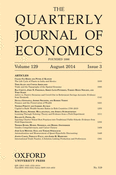-
Views
-
Cite
Cite
Treb Allen, Costas Arkolakis, Trade and the Topography of the Spatial Economy , The Quarterly Journal of Economics, Volume 129, Issue 3, August 2014, Pages 1085–1140, https://doi.org/10.1093/qje/qju016
Close - Share Icon Share
Abstract
We develop a general equilibrium framework to determine the spatial distribution of economic activity on any surface with (nearly) any geography. Combining the gravity structure of trade with labor mobility, we provide conditions for the existence, uniqueness, and stability of a spatial economic equilibrium and derive a simple set of equations that govern the relationship between economic activity and the geography of the surface. We then use the framework to estimate the topography of trade costs, productivities and amenities in the United States. We find that geographic location accounts for at least twenty percent of the spatial variation in U.S. income. Finally, we calculate that the construction of the interstate highway system increased welfare by 1.1 to 1.4 percent, which is substantially larger than its cost.



